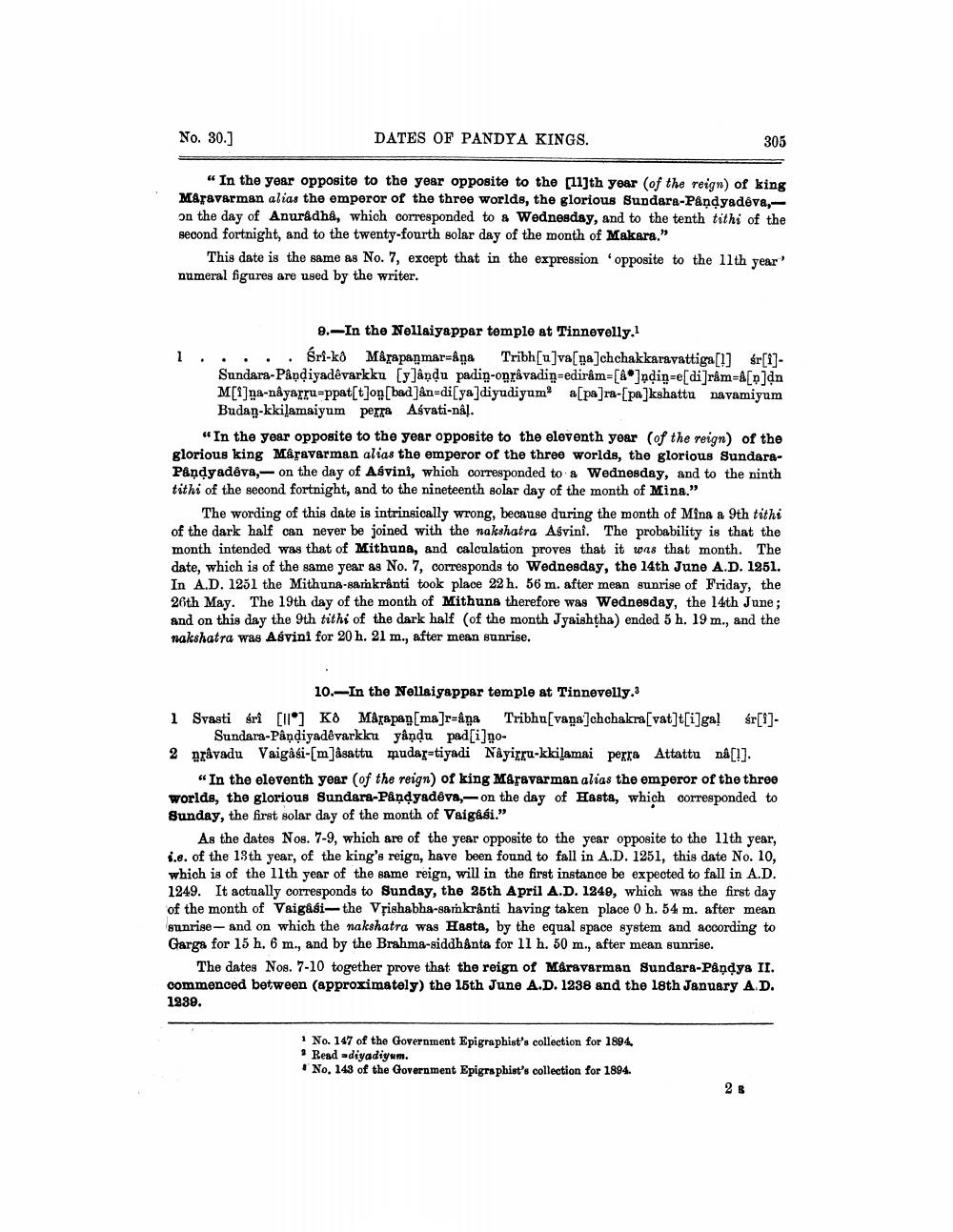________________
No. 30.]
DATES OF PANDYA KINGS.
305
“In the year opposite to the year opposite to the [11]th year (of the reign) of king Maravarman alias the emperor of the three worlds, the glorious Sundara-Pandyadêva,on the day of Anuradha, which corresponded to a Wednesday, and to the tenth tithi of the second fortnight, and to the twenty-fourth solar day of the month of Makara."
This date is the same as No. 7, except that in the expression opposite to the 11th year' numeral figures are used by the writer.
9.-In the Nellaiyappar temple at Tinnevelly. 1..... Śri-k8 M&rapanmar=&ņa Tribh[u]va[na]chchakkaravattiga[1] Sr[i]
Sundara-Pandiyadêvarkku [y]ându padin-onråvadiņ=ediråm=[&®]ņdine[di]râm=[]dn M[i]na-nayarru-ppat[t]on[bad]&n=disya]diyudiyum a[pa]ra-[pa]kshattu navamiyum
Budan-kkilamaiyum perra Aśvati-nal.
"In the year opposite to the year opposite to the eleventh year of the reign) of the glorious king Måravarman alias the emperor of the three worlds, the glorious SundaraPåndyadêva, on the day of Asvini, which corresponded to a Wednesday, and to the ninth tithi of the second fortnight, and to the nineteenth solar day of the month of Mina."
The wording of this date is intrinsically wrong, because during the month of Mina a 9th tithi of the dark half can never be joined with the nakshatra Asvini. The probability is that the month intended was that of Mithuna, and calculation proves that it was that month. The date, which is of the same year as No. 7, corresponds to Wednesday, the 14th June A.D. 1251. In A.D. 1251 the Mithuna-samkranti took place 22 h. 56 m. after mean sunrise of Friday, the 26th May. The 19th day of the month of Mithuna therefore was Wednesday, the 14th June; and on this day the 9th tithi of the dark half of the month Jyaishtha) ended 5 h. 19 m., and the nakshatra was Asvini for 20 h. 21 m., after mean sunrise.
10.-In the Nollaigappar temple at Tinnevelly. 1 Svasti eri [ll"] K8 Mapapan[ma]r=aņa Tribhovana']chchakra[vat]t[i]ga! śr[]
Sundara-Pândiyadêvarkku vându pad[i]go2 grävadu Vaigàsi-[m]åsattu mudar-tiyadi Nayirru-kkilamai perra Attattu nâ[1].
“In the eleventh year of the reign) of king M&ravarman alias the emperor of the three worlds, the glorious Sundara-Pandyadêve, on the day of Hasta, which corresponded to Sunday, the first solar day of the month of Vaigasi.”
As the dates Nos. 7-9, which are of the year opposite to the year opposite to the 11th year, 1.6. of the 13th year, of the king's reign, have been found to fall in A.D. 1251, this date No. 10, which is of the 11th year of the same reign, will in the first instance be expected to fall in A.D. 1249. It actually corresponds to Sunday, the 25th April A.D. 1249, which was the first day of the month of Vaigåsi-- the Vpishabha-samkranti having taken place 0 h. 54 m. after mean sunrise and on which the nakshatra was Hasta, by the equal space system and according to Garga for 15 h. 6 m., and by the Brahma-siddhanta for 11 h. 50 m., after mean sunrise.
The dates Nos. 7-10 together prove that the reign of Maravarman Sundara-Pandya Ir. commenced between (approximately) the 15th June A.D. 1238 and the 18th January AD. 1289.
1 No. 147 of the Government Epigraphist's collection for 1894. • Read diyadiyum.
No. 143 of the Government Epigraphist's collection for 1894.
28




